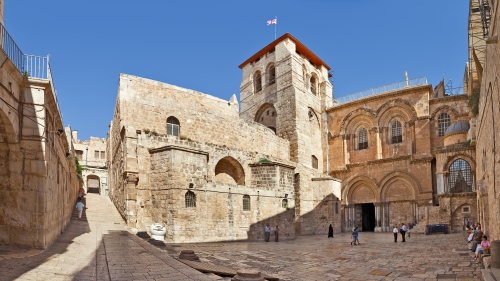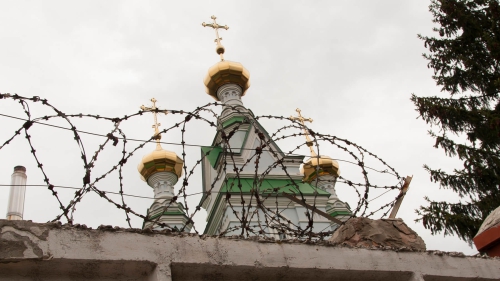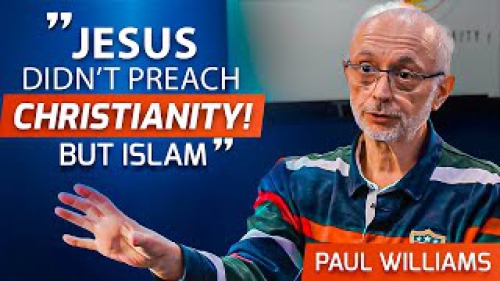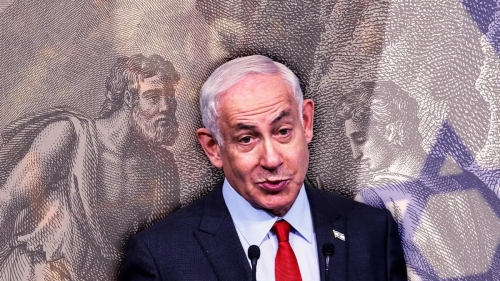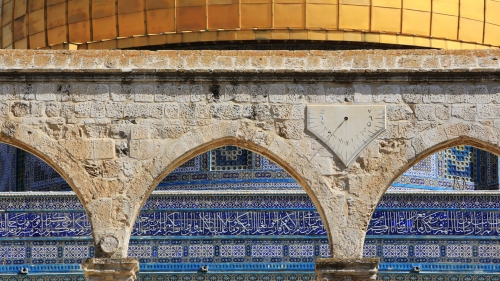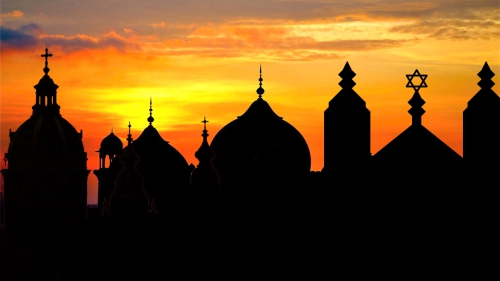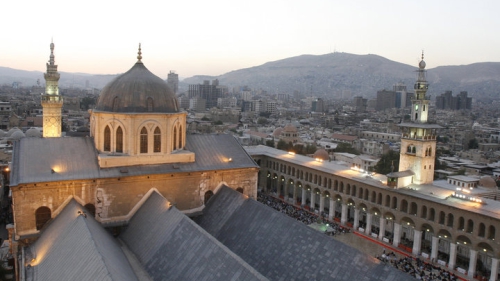Fundamentalists and the Millennium: A Potential Threat to Middle Eastern Peace
At the beginning of February, the heads of the Central Intelligence Agency (George J. Tenet) and the Defense Intelligence Agency (Lt. Gen. Patrick M. Hughes) made presentations to the U.S. Senate Armed Services Committee on current and projected national security threats.
Among those threats, General Hughes declared, is the forthcoming millennium: "One can imagine a 'millennial net effect' in which the Y2K problem, localized conflict, incidental events, unintended consequences [in the networked world], the millennial expectation, fear of the unknown, and the effects of weather and other natural phenomena [earthquakes], combine with religion and culture to create an expectation of radical change..."
These fears of a "millennial effect" were reiterated a few days later at a congressional hearing on counter-terrorism by FBI director Louis Freeh, who warned: "With the coming of the next millennium, some religious apocalyptic groups or individuals may turn to violence as they seek to achieve dramatic effects to fulfill their prophecies."
In no part of the world is this potential danger greater than in the Middle East.
Early in January, Israeli police officials arrested eight American members of a Denver-based apocalyptic cult who, the officials said, were planning to mark the millennium by committing suicide or provoking their own killings in the streets of Jerusalem. The eight belonged to the Concerned Christians cult, whose members disappeared early last fall, emptying out their houses and leaving Colorado without a trace. The cult members planned to destroy themselves shortly before the millennium in order to hasten the Second Coming of Christ, police officials said.
At the house in Israel occupied by this cult an audio cassette was found, together with photocopied charts. At the center of the first chart is a picture of Charles Manson, whose California cult perpetrated 1969's Tate and La Bianca murders. The voice on the tape, explaining how Manson's murder of actress Sharon Tate was a sign of the End, is that of Concerned Christians leader Monte Kim Miller.
"It's the same theme of redemption for a very few following great violence."
The Jerusalem Report notes that, "When Monte Kim Miller started Concerned Christians in Denver in the mid-1980s, it was a fundamentalist Christian group opposed to what he saw as New Age influences. Over time, he transformed it into a sect that regards him as a prophet who speaks in God's voice. He identified America as the Antichrist and ordered followers to end contact with outsiders, even relatives, all of whom were destined for Hell. Yet, some did keep in sporadic touch. Miller, they told their families, prophesied that he and another member of the group would be 'witnesses' who, according to the Book of Revelation, would die in the streets of Jerusalem and be resurrected 311/42 days later. It would happen in December 1999. Last fall, he and his followers disappeared."
In his cassettes, Miller lectures on history, turning dates and names into evidence that apocalyptic prophesies are coming true. In a 1995 tape, he linked the name Britain to "tin," then to the 10 horns of the beast in Revelation 17:12, which he identified as the 10 articles of the American Bill of Rights. In the Manson tape, Miller becomes hallucinatory. "Manson" becomes "Son of Man," and is described as "a counterfeit, and sometimes a picture of Jesus Christ, the Son of Man." Referring to a film made by Tate's husband, director Roman Polanski, Miller explains that, "The killing of Sharon Tate and her baby, particularly the baby, represents the killing of Rosemary's baby, which is a killing of the Roman Antichrist by the Lord...The Manson murders foretell the slaying of America's Antichrist and America itself by the Lord."
Many in the religious community are concerned about the growth of cults which seek to exploit the coming millennium. Boston-based cult expert Chip Berlet states that, "As the millennium approaches, we're getting thousands of these totalitarian groups with apocalyptic visions of reality. Unfortunately, there are now very few resources to study and track them. As we approach the year 2000...all kinds of religious movements are looking at it as a time of possible violence, or cataclysm or mass suicide."
Richard Landes, director of Boston University's Center for Millennial Studies, notes that, "We're in for some very unusual behavior in the coming years. It won't stop in the year 2000. We'll be dealing with it probably for decades."
"Very Unusual Behavior"
In March 1997, 39 members of the Heaven's Gate cult were found dead in California. This group's mass suicide was connected with a belief that a UFO was approaching the earth, hidden in the tail of a comet that had recently become visible to the naked eye. Investigators think cult members believed that by dying they could join the alien spacecraft and be transported to a higher dimension.
"It's the same theme of redemption for a very few following great violence," said Charles Strozier, an expert in apocalyptic violence and a professor at the John Jay College of Criminal Justice.
Compounding everything is the ease of communication over the Internet, which Landes calls "the petri dish of prophetic and apocalyptic discourse."
Expectations of an end-times assault by demonic forces led Branch Davidians to amass weapons at their "Ranch Apocalypse" in Waco, Texas and then to fire on federal agents who raided the compound. Convicted Oklahoma City bomber Timothy McVeigh, says Professor Charles Strozier, was "transformed psychologically" by his pilgrimage to Waco during the standoff. McVeigh then allegedly chose the anniversary of the Waco fire as the date he would bomb the federal building in Oklahoma City.
Professor Paula Fredriksen, who teaches religion at Boston University, states that, "One need not strain to whiff the scent of burgeoning apocalyptic enthusiasms. Flying-saucer cultists, para-military survivalists, prophets of eco-death, Nostradamean sages: it all swirls by, in the newspapers, on the Internet."
In his book Arguing the Apocalypse, Professor Stephen O'Leary of the Annenberg School of Communication at the University of Southern California traces the history of the Millerite movement in early 19th century America. For long years William Miller had been predicting an apocalyptic climax, but then, in 1840-after reinterpreting prophecies in the book of Daniel, and recasting Bishop Usher's chronology of the world-Miller named a precise date in 1843 as the expected date of the end.
O'Leary notes that suddenly membership in Miller's group surged, both in numbers and in the social prominence of its enthusiasts. However, when the prophecy failed, the group transmuted successfully into the Seventh Day Adventists. What struck O'Leary was the effect of Miller's actually naming a date. It concentrated and even raised apocalyptic expectation, and prompted fence-sitters to commit. Miller's prediction made the period between 1840 and 1843 an "apocalyptic hot zone." Now, O'Leary says, "With the year 2000, we're in one too. The millenarian Zeitgeist will really heat up."
In O'Leary's view, there is likely to be more millennial violence. He cites the Tokyo gas attacks ordered by Asahara, empowered by a mix of Buddhism and Nostradamus, and suicide bombers nourished on the apocalyptic rhetoric of radical Islam. Such violence, he argues, might either anticipate the End or strive to hasten it. And the more that governments try to monitor the activities of such groups, the more resentful, paranoid, and violent they are likely to become.
There is particular focus on Jews and Israel in such apocalyptic thinking. At a recent fundamentalist millenarian workshop, O'Leary took notes on the sermon of a Christian Zionist preacher. The man supported Jewish immigration to Israel because he understood God's plan. The Romans killed one million Jews in Jerusalem when they destroyed the Temple, he said, because Israel "did not know the time of their visitation" (i.e., convert to Christianity). In the 1940s Hitler killed one-third of world Jewry. Now, if only enough Jews move to Israel, fully two-thirds will be killed at Armageddon. But for those who survive, there will be a happy ending. The churchman promised that the remnant of Israel will be saved, finally, by converting to Christ.
John Nelson Darby, a 19th century Englishman, after studying the Bible's apocaylptic prophecies, came up with an end times-theory known as premillennial dispensationalism. Darby concluded that history was divided into seven ages-or dispensations-that will culminate in the Second Coming.
Darby's thinking came to dominate Christian evangelical theology in the 20th century, popularized by books like Hal Lindsey's 1970 best-seller, The Late Great Planet Earth, and Dallas Theological Seminary Chancellor John Walvoord's Armageddon, Oil and the Middle East Crisis. Both writers used current events to explain mysterious biblical images and to fashion intricate end-times scenarios.
Their script begins with Christians suddenly being pulled out of the world in an event called "the Rapture." Non-believers are left behind to face the Great Tribulation, a seven-year period ruled by the Antichrist. Eventually, world powers are drawn into a Middle East war and face off in the battle of Armageddon, a nuclear holocaust that is stopped at its climax by the arrival of Jesus, who defeats the evil forces and establishes his golden era.
Yearning for the End
It is because of their yearning for the end of the world that many American fundamentalist leaders such as Jerry Falwell and Pat Robertson have embraced the most extreme Israeli positions regarding the Holy Land and have opposed efforts at achieving a compromise peace settlement between Israelis and Palestinians.
When he visited Washington in January 1998 to meet with President Clinton, Israeli Prime Minister Binyamin Netanyahu first met in Washington with evangelical Christian leaders. The Washington Post (Jan. 22, 1998) reported: "Netanyahu, anticipating pressure from the administration to speed Israeli troop withdrawal from the West Bank, received a rapturous reception...organized by Voices United for Israel, a group of conservative Jews and Christians opposed for now to any further territorial concessions by Israel to the Palestinians. Chanting 'Not One Inch!' the crowd of more than 500 gave Netanyahu a standing ovation, as he was greeted by the Rev. Jerry Falwell..."
In an interview with The Post, Jerry Falwell described the West Bank, where Palestinians hope eventually to have their own independent state, as "an integral part of Israel." Pressing Israel to withdraw, he added, "would be like asking America to give Texas to Mexico, to bring about a good relationship. It's ridiculous."
The alliance between Jewish and Christian fundamentalists who reject the movement toward Middle East peace is, of course, an unusual one. Whether all of Mr. Falwell's Jewish supporters actually understand the theology upon which his opposition to the peace process is based is uncertain. That the pursuit of this fundamentalist vision may lead to violence, however, becomes more than clear as their motives and goals are understood.
In her book Prophecy and Politics, Grace Halsell reports on two trips she took to Israel with Falwell's fundamentalist group: "On two Jerry Falwell journeys to the Holy Land, I mingled with many dispensationalists, among them Owen...He explained his belief system, which entails the need to destroy Jerusalem's most holy Islamic shrines revered by about a billion Muslims around the world, and the necessity of a nuclear Armageddon to destroy Planet Earth...Owen told me, as we stood in Jerusalem's Old City looking at the Dome of the Rock, that biblical prophecy 'demanded' that Jews destroy the shrine and build on the site a Jewish temple. Jewish terrorists-who had stormed the mosque with the intent to dynamite and obliterate it-were heroes to Owen. I learned that Jewish terrorists were heroes to many others, including such wealthy and influential Jews as Haagen-Dazs ice cream baron Ruben Matus, Jewish Press editor Yehuda Schratz, and Mexican arms dealer Marcus Katz, who had sent hundreds of thousands of dollars to the Jewish underground."
In 1979 Jerry Falwell declared that, "In spite of the rosy and utterly unrealistic expectations by our government [from the Camp David accords involving Israel and Egypt], this treaty will not be a lasting treaty...You and I know that there's not going to be any real peace in the Middle East until one day, the Lord Jesus sits down upon the throne of David in Jerusalem. That day is coming. And for sure, you and I are going to be a part of it. But until then, there is not going to be any peace on this earth until the Prince of Peace, our Savior, returns."
At a 1980 gala dinner in New York, Falwell was given the Vladimir Ze'ev Jabotinsky medal by Menachem Begin. Jabotinsky, the founder of Revisionist Zionism, held that Jews settling in Palestine should not be held accountable to the laws of men. He sought the creation of a Jewish state "on both sides of the Jordan River."
Dr. William Gordon, a Presbyterian minister and professor and co-author of Jerry Falwell: An Unauthorized Profile, states that, "Falwell is the only Gentile ever to receive the Jabotinsky medal. The only difference between his and Jabotinsky's philosophy is that Falwell talks of Christ. But he talks of a militant Christ, a kind of Jabotinsky Christ. Falwell likes Israel not in spite of but because it is militarily aggressive. He admires Israel because it has a big standing army, a big air force, and a huge array of tanks and nuclear weapons. After pinning the Jabotinsky medal on him, the Israelis utilized Falwell for their purposes to an even greater degree...They made good use of him during their 1982 invasion of Lebanon. Falwell had nothing but praise for the invasion...
"When the massacres occurred at the two Palestinian camps, Falwell just mimicked the Israeli line: 'The Israelis were not involved.' And even when The New York Times was giving eyewitness accounts of Israeli flares sent up to help the Phalangists go into the camp, Falwell was saying, 'That's just propaganda.'"
One goal of religious fundamentalists, both Jewish and Christian, is the rebuilding of the Temple in Jerusalem. Terry Reisenhoover, a fundamentalist leader, heads the Jerusalem Temple Foundation. As his international secretary he chose Stanley Goldfoot, a member of the notorious Stern Gang who is reported to have been involved with the bombing of the King David Hotel in 1946.
It is the foundation's belief that God gave the Holy Land to Abraham and his son Jacob and not to Abraham's other son, Ishmael. As Goldfoot deputy Yisrael Meida, a member of the ultra-right Tehiya Party, explains: "It's all a matter of sovereignty. He who controls the Temple Mount controls Jerusalem. And he who controls Jerusalem, controls the Land of Israel. This is the land of Israel, not the land of Ishmael."
In her book Jerusalem: One City, Three Faiths, former Catholic nun Karen Armstrong writes that, "In Jerusalem, the new far-right activists centered increasingly on the Temple Mount. In 1978, Rabbi Shlomo Aviner founded the Yeshivat Ateret ha-Kohanim ("Crown of the Priests Yeshiva") as an annex to Rabbi Kook's Merkaz Harav. One of its objectives was to Judaize the Old City...
"The chief work of the new yeshiva, however, was to study the religious meaning of the Temple, a task reserved for the Messiah, but his deputy, Rabbi Menachem Fruman, wanted his students to be ready to undertake the Temple avodah when the Messiah did arrive-an eventuality he expected in the near future. He began to research the rules and techniques of sacrifice and instructed his students in this lore."
Others, however, believed that more decisive action was necessary. Armstrong writes: "Shortly after Sadat's visit to Jerusalem, two Gush members, Yehuda Etzion and Mehachem Livni, began to hold secret meetings with a Jerusalem Kabalist called Yehoshua Ben-Shoshan. Gradually an underground movement was formed whose chief object was to blow up the Dome of the Rock. This would certainly halt the peace process...
"This spiritual revolution, they believed, would compel God to send the Messiah and the final Redemption. Livni, who was an explosives expert, calculated that they would need 28 precision bombs to demolish the Dome of the Rock without damaging its surroundings. They amassed huge quantities of explosives from a military camp in the Golan heights."
In the end, this plot failed. The fact remains, however, that it appears to be a goal of both Jewish and Christian fundamentalists to restore the Temple by destroying the Dome of the Rock in order to provoke the coming of the Messiah-either the first coming, in the case of the Jewish fundamentalists, or the second coming, in the case of the Christians.
Evolution of a Wild Notion
In his book Arabs and Jews: Wounded Spirits In A Promised Land, David K. Shipler, who was Jerusalem bureau chief for The New York Times from 1979-1984, reports: "During my five years in Jerusalem, the idea of building a Third Temple in place of al-Aqsa and the Dome of the Rock evolved from a wild notion held by a very few fringe militants into a goal embraced and legitimized by parts of the established right wing. Some groups had a letterhead printed with a composite aerial photograph of the Old City as it is today and the Temple Mount as they wish it to be tomorrow: clear of mosques and dominated by a huge temple....In 1969 an Australian Christian set fire to al-Aqsa, and an Israeli soldier ran into the Dome of the Rock spraying gunfire in all directions in 1982."
In August 1985 the first Christian Zionist Congress was held in Basel, Switzerland. Nearly 600 people from 27 countries attended the Congress sponsored by the International Christian Embassy, a Jerusalem- based group with close ties to the Israeli government. The Christian Zionists urged Israel to annex the West Bank.
An Israeli Jew, seated in the audience, rose before the motion was voted upon to suggest that perhaps the language might be modified. He pointed out that an Israeli poll showed that one-third of the Israelis would be willing to trade territory for peace with the Palestinians.
"We don't care what the Israelis vote!" declared Jan Willem van der Hoeven, director of the Christian Embassy. "We care what God says! And God gave the land to the Jews." After his impassioned declaration, the Christian Zionists, by a nearly unanimous vote, passed the resolution.
Boston University's Richard Landes cautions Jews about their relationship with fundamentalists who yearn for the Battle of Armageddon: "These pilgrims have, by and large, a deep-seated ambivalence to Jews and to Zion...In their view, Zionism...represents at best a momentary element in God's plan, legitimate only insofar as it participates in gathering Israel together and thereby bringing God's kingdom to earth. But from their perspective, secular Zionism is part of a Godless modernity and Judaism a religion superseded by Christianity; ultimately, therefore, Jews will convert, and Zionism will yield to the millennial rule of Jesus.
"Judaism is, in almost all Christian eschatology, a vehicle to an end which will, by disappearing, lead to that End...As we know from Jewish history, apocalyptic zealots are capable of immense and ruthless violence, as well as an unhesitating willingness to commit suicide for the cause."
No single modern event has stirred more apocalyptic enthusiasm than the founding of the State of Israel. Since much of the end-times drama revolves around Israel, its nearly 2,000-year absence from the world scene has posed a problem for many prophecy believers. Thus, when Israel emerged in 1948, premillennialists exulted that the final countdown had begun.
For many Orthodox Jews, Israel's founding also stirred Messianic expectations linked to biblical prophecies that the Temple in Jerusalem, destroyed by Romans in 70 A.D, would be rebuilt and herald the coming of the Messiah.
The harm in all of this, says Timothy Weber, author of Living In the Shadow of the Second Coming, comes when people place their interpretation of prophecy alongside such key tenets of the Christian faith as the divinity of Jesus, the Virgin Birth and the Resurrection as part of a "self-contained doctrinal package." Not only do they claim to pinpoint current events as fulfillment of God's plan but they assign hero and villain roles in the divine scenario to their contemporaries. And once people are identified as part of the end-times apostasy, says Weber, there is "no reason to treat them as anything but enemies of God."
Dr. Yair Bar-El, chairman of the Israeli Psychiatric Society, predicted that some 40,000 of the 4 million tourists expected during the coming year will require psychiatric help as a result of messianic mania. "People with deep beliefs will be expecting to witness apocalyptic events that will change the face of humanity," he said.
With the year 2000 rapidly approaching, apocalyptic violence is a growing concern and, many believe, an inevitable product of religious zealotry. And no place is more threatened than the Holy Land, in which such apocalyptic thinking is growing and a strange alliance of Jewish and Christian fundamentalists threatens the already fragile peace.
Allan C. Brownfeld is a syndicated columnist and associate editor of the Lincoln Review, a journal published by the Lincoln Institute for Research and Education, and editor of Issues, the quarterly journal of the American Council for Judaism.
Article first appeared in the June 1999 edition of the Washington Report On Middle East Affairs. Reprinted with permission.
Topics: Christianity, Crime And Justice, Homeland Security
Views: 940
Related Suggestions







